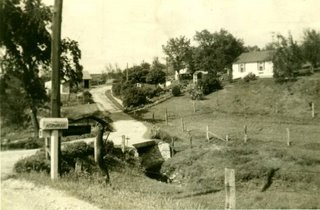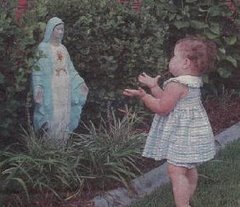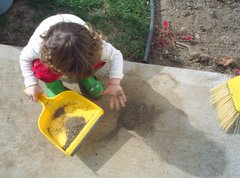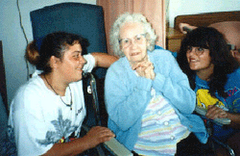Aug 12, 2006
Omism, a New Religion
I think Omism will develop as a light lunch buffet of religious beliefs and practices that combines a variety of different faiths. This new religion will identify itself as containing the best of Protestantism, Catholicism, Taoism, Buddhism, Hinduism, etc.
Well, 'Omism' is here. Actually not yet in the U.S., but in Italy. The Vatican is alarmed about a best-selling book that presents Asian mysticism and spirituality as the keys to life. The author, Tiziano Terzani, argues that people have an “innate moral sense” and do not need institutionalised religion to teach them right and wrong. [Yes, except will the devil argue your case at judgment time?]
One critic said the book was “a confused mixture of Oriental philosophy, Marxism and Christianity” that muddled “St. Francis with Zen Buddhism”. In the past, Pope Benedict XVI has warned of the dangers of trying to reconcile Oriental and New Age spirituality with Catholicism.
Do you know how I picture Omism? As a twisting black smoke snake that my kids used to light on the ground at Fourth of July.
Aug 11, 2006
The "Guide" of Religions in China
 A search for 'Catholic' on the official China news website brings up a recent interview with Ye Xiaowen, director of the State Administration of Religious Affairs. The interview represents Ye's first open remarks since he took office ten years ago. [He never once mentions God in the interview.]
A search for 'Catholic' on the official China news website brings up a recent interview with Ye Xiaowen, director of the State Administration of Religious Affairs. The interview represents Ye's first open remarks since he took office ten years ago. [He never once mentions God in the interview.]Ye claims his country has "more than 100 million faith followers," and he wants them to focus on peace, non-violence, and environmental protection. Thus he denies that religion's primary purpose is the spiritual welfare of men--to assist them to live a good life and die well. Of course, Communists don't believe men have eternal souls that are accountable to God, do they?
I am sure that the Pope looks at the possibilities for China to be a great country if that large and increasingly powerful nation were to believe in the true God and renounce atheistic materialism that leads them to a hell on earth--no matter how rich they become.
Listen to Ye as he insists China must "guide" religions.
First of all, the government will guide the religions to try to explain their tenets in ways that are in line with the requirements of the development of the society. Other religions are also facing the need of fresh explanation of their tenets to keep pace with the social developmentThe old Communist Chinese government really believes it is capable of explaining the tenets of Catholicism! What a cow! Clearly, the only hope of Christians in China is for the old communist, Ye, to be replaced by a more perceptive individual who understands the good that faithful Christians have accomplished in other societies of the past and the immense good that Catholic teaching can do for China in the future.
The Joy of My Youth
The first prayer of the old Latin Mass is from David's Psalm 43: 4-5 and contains the phrase, "to God the joy of my youth." This prayer recognizes the joyous encounter of King David as a child with God. This post tries to understand why David had such a joyful childhood, and how his happy childhood might be imitated today.
Almost everyone knows David was annointed King of Israel by Samuel, killed the Philistine giant Goliath with a slingshot, and was the most famous Israelite King in history. Yet there is no history of his early life tending the sheep while his brothers followed King Saul. What is the life of a young shepherd when he later refers to "God, the joy of my youth"?
In the Middle East, rocks are used to construct fence walls and enclosures for animals. With the help of his dog, David probably penned his small flock of sheep in one of these enclosures at night. Even while sleeping next to his dog, he would have sensed problems with the sheep (they are good at baa-ing if they sense trouble).
David would have been delighted at the birth of new young lambs, and their finding their mothers to nurse for the first time. Perhaps he would have coaxed a ewe who had a stillborn lamb to accept one of triplet lambs.

At night, David would feel a chilly wind and wrap himself more tightly in his wool blanket. He would have heard the many natural sounds of night, and would have been transfixed at meteors darting across the random array of stars. There would have been a silence in the countryside that was not present in his village.
In the early morning, the dog would have arisen at the sound of awakening sheep. David would have quickly packed his food and water for the trek. Then he would enter the pen, count his sheep, and made sure that all of them were able to move to the graze. After the sheep would have been let out of the pen, David and his dog would have kept them moving to the graze. The early morning temperature would have been cool, but the fast walking would have warmed the young shepherd. On the way, the sheep would stop at a creek for water, and David and his dog would have drunk too.
If a ram were around, David would keep a close eye on him because of having bruises from being butted hard in the past. The young shepherd would have a wood stick with a hook on the end of it--to use in walking, to protect himself from rams, and to capture sheep by hooking their rear leg. David would have looked often at the well-worn crook that had been passed down to him when his grandfather died.
A new grazing area would have been at some distance from the protected holding pen, and the sheep were always extra hungry when reaching their graze. During the time when they were unsettled, David and his dog would have worked hard to keep the sheep from wandering off to nearby trees and shrubs. Before too long, the sheep would have recognized the boundaries of their graze, because the dog would nip and bark when the sheep started to move outside the designated area.
David's flock would have settled into a pattern of moving across their graze. The grazing pattern
usually takes the shape of a fan with the flock's dominant sheep at the apex of the curve. The sheep methodically "mow" the grass as they move across the meadow. They maintain the fan shape most often when they are eating grass that is uniformly shorter than about six inches. If the sheep are grazing sparse patches of grass, a stubble field, lush tall grass or a planting of diverse species, the flock will not graze in a unified pattern. Instead, each member of the flock will be looking for the biggest bite of sparse or tall grass, and in the case of a diverse planting, each sheep will be searching for his favorite morsel.
David observes the sheep grazing contentedly for a while and he sits on a rock to eat a late-morning meal. The dog joins him and lays down at David's feet to eat small pieces that he knows will drop from David's bread, cheese, and meat. When the sheep begin to approach forbidden or dangerous areas, David arises from the rock to work with his dog to bring the sheep back to the intended grazing area. The sun is bright, the grass is green, and the world looks very good to David. Or it is cloudy and he suffers through a damp, chilly day to look forward to the good weather he knows he will probably have tomorrow.
In the late afternoon, the sheep are herded the long way back to the holding pen. David and his flock stop at a small stream so that the sheep can drink. While the sheep are drinking, David picks up stones and sticks to toss in the water, or if the water is wide, he throws stones from his sling, making them skip across the water. He found life in the water--snails, frogs, water spiders, crayfish, or small minnows. He kept one eye on the sheep, but I suspect David stayed at the stream to play for as long as he dared.
When David arrived with his sheep at the holding pen, he would have looked each one over carefully before penning them. As he touched the sheep, his hands would have absorbed some of the lanolin in the wool. [A sheepherder's hands are never rough.) His mother, or one of his father's servants, would have brought him food for the evening and the next day. They would have exchanged details of the day's events. Other boys would have arrived and David would have shown them the special rock or toad he had found. They would have discussed the children in the next village who recently saw a wolf.
A joyful youth such as David experienced is what we want to give our children. I experienced such a joyful childhood because of the creek and animals on my Grandma's and our adjacent farms.
There is a great joy playing in the creek and lifting a rock and finding a crawdad. If you're fast enough, you can grab him behind the pincers and put him in an old bucket. Maybe you can build a dam of rocks to hold a little pool of water. If you catch a minnow with a butterfly net, you can put it in the little pool, but he'll probably find a way out. Or you can take a cold drink from the pipe coming out from the deep, spring-fed well by the creek. Or you can look at the puffy clouds and make believe you see a horse, a bird, or a snowman.
you're fast enough, you can grab him behind the pincers and put him in an old bucket. Maybe you can build a dam of rocks to hold a little pool of water. If you catch a minnow with a butterfly net, you can put it in the little pool, but he'll probably find a way out. Or you can take a cold drink from the pipe coming out from the deep, spring-fed well by the creek. Or you can look at the puffy clouds and make believe you see a horse, a bird, or a snowman.
Some of my grandchildren are blessed to live on some acreage adjacent to a creek, and their mother tells me they play all day without being bored. Water in the creek flows over a concrete abutment, and the creek is slightly deeper there. Frogs, minnows, crawdads and some water snakes are easily found.
Once I went to Home Depot or Lowe's and bought an 80-pound bag of concrete mix. One of the grandkids got the wheelbarrow to take some of the concrete mix down near the creek. We took a gallon plastic milk jug, cut out the top, but left the handle. The kids put some water in it and added some concrete mix. They stirred it with a stick, then dumped succesive jugs of the wet mix in the creek to form a dam. Best $3.75 I ever spent on a toy! [BTW, the grandkids were told that they had to wash their hands in the creek whenever they got concrete on them.]
The Natural Wildlife Federation [not necessarily recommended for all their positions] has an interesting article excerpted from the book, Last Child in the Woods: Saving Our Children from Nature-Deficit Disorder. The author observes:
A child today can likely tell you about the Amazon rain forest but not about the last time he or she explored the woods in solitude or lay in a field listening to the wind and watching the clouds move. Parents cite several everyday reasons why their children spend less time in nature than they did. Among them: diminishing access to natural areas, competition with electronic entertainment, and time pressures, including increased homework and longer school hours.I believe people have joyful childhoods when they grow up in the outdoors and experience natural flowing water such as creeks. They also learn responsibility when they must take care of animals, like young David did. Do what you can to bless your children with a childhood that makes them acknowledge "God, the joy of my youth."
Aug 10, 2006
Pictures/Cartoons of Priestesses
Focus on the Past and the Future
- The actress, Loretta Young
- The newspaper columnist, Ann Landers
- My Grandma
- My Grandma's hired man
- A local saintly lady
- An adoption over 40 years ago
- An 'image of the future' issued in 1959
- Old stories of people who divorced
- The courtship of peasant people in another age
- The Council of Basle and its similarity with Vatican II
- Pastoral advice received over 25 years ago
- A restored Catholic comic book
- The Great Catholic Retreat--Preface
- --Chapter 1--Modernism
- --Chapter 2--Vatican II
- --Chapter 3--Running Backwards
- --Chapter 4--Pope John Paul II
- --Chapter 5--The Wind Changes
- --Chapter 6--New Growth
- --Chapter 7--Residual Trials
- --Chapter 8--Conclusions
- Spain's Future
- The Church Pendulum
- Swimming in the Tide
- Marriage Trends
Aug 9, 2006
A 1959 Image of the Modern Church
Li Wei-han wrote THE CATHOLIC CHURCH AND CUBA: A PROGRAM OF ACTION for the new Communist Party in Cuba formed by Fidel Castro. The document was published in Spanish by the Foreign Languages Press of Peking for the Latin-American Section of the Liaison Department of the Chinese Communist Party. Many years ago, the Vatican newspaper, L'Osservatore Romano, published this plan and reported it had been used against the Catholic Church in China, Czechoslovakia, Romania, Poland and Cuba.
The secret plan to take over the Catholic Church in Cuba was issued in 1959--several years BEFORE Vatican II. In hindsight, the Church following Vatican II seems to have implemented the Red Chinese plan with the disastrous results that we see today.
One Chinese recommendation was to set up a Bureau of religion in Cuba to impose "the procedure of 'democratic centralization' on the Church." Some might say the the National Conference of Catholic Bishops is similar to the religious Bureau recommended by Li Wei-Han.
Another selection from the Chinese document refers to using special laws against Catholics
who protest. They must be thought as unpatriotic criminals obeying the imperialistic instructions emanating from the headquarters of the Catholic Church, the Vatican.Are traditionalist Catholics who protest against wayward churchmen and activities targeted for discipline, while heretics and apostates escape punishment for their misdeeds?
The document says that occasionally a "two steps forward, one step backward" approach must be taken when people are psychologically torn between the Church and the government. Some would say this tactic also has been used whenever Catholics become too uncomfortable with liberal changes in the Church.
When the People's Government is performing the 'one step backward,' it must proclaim that it is .... in deference to the wishes of the masses that it is setting up Committees of reform in the associations, so that the patriotic masses can express their views more directly in the running of Church affairs.The above paragraph, if slightly modified, could easily refer to the many committees that have been enrolled in the management of Church structures since Vatican II.
A further quote,
It is important that the ecclesiastical authorities and the Bishops should assure the masses that religion has become purer as a result of being liberated from criminal and unpatriotic elements.There are a number of ecclesiastical authorities who have proclaimed the Catholic religion is more pure because of being liberated from unreasonable and old-fashioned Church laws of the past.
Does the following paragraph remind you of words that assure Catholics that they can coexist with the modern sinful world?
The task of our militants is to convince the masses that individuals can have their own religion without the Vatican having the right to dictate in the affirms of all the Churches in the world. Our militants must also explain the principle of the coexistence of patriotism and religion. In this way the masses are alienated from those who take their cue from the Vatican, and the way is opened for the establishment of an independent Church.
...we must accumulate all the arguments necessary to convince the Catholic intellectuals that a break with the Vatican is a step forward and not a step backward. ...The masses are but tenuously linked to the Vatican in their religious practices.The most important paragraph of Li Wei-Han's document that describes tactics to destroy the Catholic Church in Cuba relates to making optional the practices that were formerly considered mandatory for a good Catholic.
Once the time comes when the posts of responsibility in ecclesiastical affairs are in our hands, and their incumbents are docile to the will of the People's Government, we shall proceed to the progressive elimination of those elements of the liturgy which are incompatible with the People's Government. The first changes will affect the sacraments and the prayers. Thereafter the masses will be protected against any pressure or obligation to attend Church services, or practice their religion, or organize societies with some devotional purpose. It is notorious that when the practice of religion becomes simply a matter left to the individual's sense of responsibility, it is gradually forgotten. The rising generations will succeed the older, and the religion will become merely an episode of the past, important only as a topic to be considered in histories of the world Communist movement.
Ask yourself whether the changes since Vatican II did not almost totally eliminate the sacrifices required on Fridays and during Lent and Advent, many devotions and reverential practices, the number of Holy Days, the need for Confession before Communion, etc.
Aug 8, 2006
Why We Are Fighting Culture Wars
When Eppie Lederer took over the Ann Landers column in 1955, no one, including her, realized the tremendous impact she would have on all of us. Ann Landers was someone people could confide in, when they had nowhere else to turn....And she changed newspapers forever, becoming an intrinsic part of the American culture: Everyone knows Ann Landers.Yes, Eppie Lederer changed American culture and that's why we now have culture wars. I remember a time in the 60s and 70s when the first thing that everyone read when they opened the paper was the Ann Landers column. A 1978 World Almanac poll found that Lederer was "The Most Influential Woman in the United States." Her popularity continued through 1997 when 90 million readers of 1,200 newspapers were said to "take Lederer's counsel like a tonic."
Her day-to-day advice is what caused this nation to accept homosexuality, divorce, and abortion. Did 'Ann Landers' start out that way? Heavens, No! Most of her early columns could have been written by my Grandmother or a Catholic priest. But once she was accepted as the nation's godmother or councilor, her advice began to change.
In a 1997 interview, 'Ann Landers' said she once
accepted the early '60s definition of the American Psychiatric Association, that homosexuality was a deviant psychiatric disorder. She now believes authorities who say one is born with this orientation. Regardless of the cause, she is not judgmental and has always urged tolerance.'Landers' also convinced her readers of the ten percent myth: "According to some studies, an estimated 10 percent of individuals worldwide are homosexual."
Same thing with divorce, according to the interview.
Forty years ago her position was this: "You made a deal, stay with it thick or thin." And if the woman was in an abusive marriage: "Go to your clergyman, go to your doctor, work it out, work it out, work it out." Since then, because of her own divorce, the changing times, and public opinion, Lederer has broadened her acceptance of divorce. While brutality, alcoholism or infidelity certainly warrant divorce, she now also includes marital unhappiness or dissatisfaction: "Some people just don't belong together and it's too bad if they think they have to spend the rest of their lives together when it's not working."What did 'Ann Landers' teach about abortion? The Jewish Virtual Library notes
While in the 1950s she encouraged women to stay at home and to accept, if necessary, their husbands' infidelities, by the 1970s she was urging women to find worthwhile occupations and was a champion of liberalized abortion laws.Did 'Ann Landers' intend to change the world? She once said "I select letters [for the column] that give me an opportunity to teach people something. This was my mission from the beginning."
The Adoption That Never Was
 Loretta Young (1913-2000) was a movie star who made nearly 100 movies from 1927 through 1953. She hosted the very popular Loretta Young Show on TV beginning in 1953, and the series continued through 1961. She played the lead in 162 episodes of this drama anthology series. The Loretta Young Shows could be mostly relied on to emphasize faith and moral values.
Loretta Young (1913-2000) was a movie star who made nearly 100 movies from 1927 through 1953. She hosted the very popular Loretta Young Show on TV beginning in 1953, and the series continued through 1961. She played the lead in 162 episodes of this drama anthology series. The Loretta Young Shows could be mostly relied on to emphasize faith and moral values.Loretta Young was known for her religious faith and work on behalf of Catholic charities. Her scripts contained stories about family, community, and personal conviction, leading to the resolution of moral challenges. Every episode was summed up with a quotation from the Bible or some other recognized source. Her work was honored by numerous civic and religious groups. She was the first woman to win both an Academy Award and an Emmy Award.
I knew Loretta Young was a Catholic (but I'm not sure I knew she was divorced) when I look
 ed forward to her TV shows in the 50s. She was well-known for being one of the two energetic nuns in the hit movie of 1949, Come to the Stable. After the end of her TV series, she retired but returned in 1986 to earn a Golden Globe Award for her performance in a made-for-TV movie, Christmas Eve, that was far above the secular movies of the time. Her last appearance was in another TV movie in 1990. She continued to be active in Catholic charities until she died in 2000 at the age of 87. Her TV shows are now being run on Sky Angel and are sold by Amazon.com.
ed forward to her TV shows in the 50s. She was well-known for being one of the two energetic nuns in the hit movie of 1949, Come to the Stable. After the end of her TV series, she retired but returned in 1986 to earn a Golden Globe Award for her performance in a made-for-TV movie, Christmas Eve, that was far above the secular movies of the time. Her last appearance was in another TV movie in 1990. She continued to be active in Catholic charities until she died in 2000 at the age of 87. Her TV shows are now being run on Sky Angel and are sold by Amazon.com.Now, for the rest of the story.
Loretta Young was already a very successful young actress when she made a hit movie in 1935 with Clark Gable as her co-star. She was attracted to his famous masculine image. What happened next was that Loretta became pregnant by a married man not her husband.
She did what many Catholic girls did at that time, she hid her pregnancy to avoid the scandal and to prevent cancellation of her studio contract which prohibited immoral behavior. In those days, unmarried pregnant girls who did not marry the father of their child usually went to another town 'on vacation' or to 'visit an aunt' (Loretta and her mother went to Europe). Then the baby of the unwed mother was usually given up for adoption. In many instances, the girl returned home with no one the wiser.
Loretta Young decided to keep her new baby girl, a rarity in that age. But how? She announced that she was planning to adopt a baby that needed a home. In the terrible depression of the mid 1930s, Loretta's action was viewed as admirable. So Loretta's baby was "adopted," received the name of Judy, and lived with Loretta Young. After Loretta was married in 1940 to Thomas Lewis, the little girl took the name of Judy Lewis. Loretta's daughter continued to be told she was adopted as she grew. But she inherited her famous Dad's ears and these were surgically altered.
According to Judy's autobiography, she first heard that Clark Gable was her father from other children at school. But only after her first child was born did Judy Lewis definitely learn there was no adoption and that Loretta Young was her birth mother and that Clark Gable was her father.
Loretta Young committed a number of public sins during her lifetime, including divorce and remarriage, affairs with married men, and wearing low-cut dresses. Yet in an interview with Palm Springs Life magazine about four years before she died, she said Ingrid Bergman once asked her
"Do you really believe that there is anything after this life?" And I said, "Oh, I'll say. That's why to me every single solitary moment is so important. What I do here is going to decide whether I go to heaven or hell. And when I was 16 I decided I was not going to go to hell. And you can decide that. You may boo-boo 10 times a day. That's why we have confession. As long as you're sincere and trying to break the habits." Well we had a heartfelt discussion and I said I was preparing for the afterlife every day.Marlene Dietrich, not the kind of famous actress a Catholic would like to imitate, nevertheless gave Loretta Young a remarkable compliment that I'll always remember, "Every time she 'sins,' she builds a church. That's why there are so many Catholic churches in Hollywood."
Aug 7, 2006
Two Types of Family Farms
 Some traditionalist Catholic bloggers want to remove themselves from the city to an agrarian life, including Fr. Lawrence Smith who was interviewed recently by Stephen L.M. Heiner. Fr. Smith has chosen to live near a very small community in Wisconsin because he believes city life is not conducive to Catholicism and:
Some traditionalist Catholic bloggers want to remove themselves from the city to an agrarian life, including Fr. Lawrence Smith who was interviewed recently by Stephen L.M. Heiner. Fr. Smith has chosen to live near a very small community in Wisconsin because he believes city life is not conducive to Catholicism and: The medieval economic model was wedded to the Faith. The modern economical model attacks the Faith.
The forced migration of the entire earth to cities is the destruction of freedom; it is the corralling of people so that they are wholly dependent on Big Brother – this attacks both the family and the Church. This means the powers that be can starve you to death if they please. The fear of being starved to death allows the powers that be to coerce the obedience of those thus enslaved.I believe that an agricultural life might be feasible for families in the 21st century, but it likely to take some very modern things to accomplish it. Let's start with describing how a self-sufficient farm operated about 75 years ago.
A Small Family Farm in the 1930s
My Grandma had a approximate 20-acre truck farm (couple of cows, a horse, chickens, pigs, berries, grapes, fruit trees, vegetables, alfalfa) located across the road and creek from where I grew up as a child. She earned her entire income from this farm.
The hired man used a horse to prepare the ground for planting and to cultivate between the close rows of berries and vegetables. The manure was stored in piles and later carried to the field on a sled for distribution as fertlizer.
Grandma never had water piped inside her small house. The outhouse was about fifty feet from her front porch on which we sat, talked, and shelled lima beans during hot summer evenings. Indoor recreation consisted of talking among family members and visitors, and playing games and cards. Outdoor recreation consisted of horseshoes, walking, raising goldfish, playing in the creek and catching crawdads, and shared meals and conversation with relatives and friends who visited.
Her always cool water for drinking, cooking, cleaning, and bathing came from either a cistern or by walking from the house down to a spring-fed well at the bottom of the hill and then carrying the buckets back up the hill to the house. A creek was close to the west edge of her property, along the county road.
Grandma had no basement, just a cellar dug in the dirt under the house. A couple of casks of home-made wine and jars of preserved fruits and vegetables could be found in the cool cellar. In the fall and winter, a crock was filled with shredded cabbage to ferment into sauerkraut. A truck with many cross-slats to hold crates of berries, vegetables, and fruits was used to transport produce to the City Market about every two or three days during
 picking seasons.
picking seasons.The barn was used to store farm tools, provide shelter for the horse and cows, and allow hay to be kept protected in the loft. A small white chicken house was located close to the outhouse and further away from the hired man's one-room house. A pig shed completed the buildings on Grandma's farm.
Grandma's farm was mostly self-sufficient during the depression of the 1930s and during the rationing of essential items during World War II. They still needed to buy gasoline and tires for the truck to take produce to the City Market, electricity for lights and the cook stove, coffee, sugar for canning, clothes and shoes, and a few other things. But they had food, water, and a warm house with a wood stove. Grandma told me she could make bleach from wood ashes and also make soap from the lard of her pigs if she had to, but she usually bought these items. She was assisted in farming by a hired man and my Mother. During picking season, poor people were hired and paid by the box.
The major uncertainly was the weather. One spring the crops were planted and a freeze in mid to late May destroyed all the young plants. Everything had to be replanted and my Mother remembers that they produced very good crops for the rest of the summer.
Rainfall was problematic and I remember my Grandma and Mother (who helped Grandma with farming) praying many times for rain during periods of drought. Only the vegetables planted near the creek could be fairly easily watered during dry spells.
Children either went to a Catholic school or a much closer public school.
Small Family Farms in the Early 21st Century
Several Catholic families, each with a number of children, live west of Kansas City on acreage that ranges from several acres to about twenty acres. Taken as a whole, here are some of the elements that distinguish a small family farm in the 21st Century.
- The fathers all work at salaried or self-employed jobs with benefits (either paid for by self or by an employer). Most parents are well-educated.
- The family saved up sufficient money to buy land and a typically large house in the early years of marriage
- All the farms have barns; some shelter horses, cows, goats, and lambs, and store hay
- Farming is on a significantly smaller scale because mass production of animals and eggs means these products are often bought more cheaply than if they were raised
- The great majority of family food is bought, rather than raised, especially during non-harvest seasons and when fresh and frozen products are desired
- At least one family has a chicken house and raises chickens and eggs, although the reason for the chickens is simply to teach the children to work and be responsible
- Horse manure is picked up from the pasture and barn and used for garden fertilizer
- Homes are plumbed with water and waste systems (septic tanks)
- None of the houses have installed cisterns to trap and store water from rainfall on the roof
- Water is obtained from rural water systems
- New houses are well-insulated and heated using high-efficiency wood fireplaces and propane furnaces
- Houses have refrigerators and freezers to store food
- Air conditioners are used during hot periods
- Inside recreation consists of CD and DVD players and electronic games
- Cooking stoves are propane or electric
- Horses are not used as draft animals but for recreation
- Gasoline powered tools are the norm, including lawn tractors
- Gasoline and propane are often purchased in quantity and stored on the farm
- A limited number of berries, vegetables, and fruits are raised for home consumption but are not sold for money
- Trees and plants are irrigated during droughts
- Garage sales and Ebay are patronized for clothes, shoes, house items, toys, etc.
- Families often share children's clothes and expensive equipment with each other
- Labor for the farm is supplied, not by hired hands, but by parents and their children.
- Outdoor family recreation on the farm includes playing in creeks and barns, catching crawdads and minnows, riding horses and 4-wheelers, swimming in large plastic pools, jumping on trampolines, and shooting BB guns and arrows
- One family has installed wind turbines and solar cells to generate electricity that is stored in over a ton of lead acid batteries; In most periods, this family is able to provide electricity for all their home needs
- Children are almost all home-schooled.
Argent and the Poncho Ladies
What I really like most about Argent's post is his name for the priestesses--Poncho Ladies.TM
Aug 6, 2006
Why Write?
One of their discussion boards looks at "Where Has Writing Brought You?" Various answers were presented on why these Catholic authors write:
- Delving into all kinds of subjects, such as languages and cultures and countries
- Learning to love the study of philosophy and ethics
- Deepening an appreciation for the Catholic religion, and for the field of apologetics
- An obligation to share with others the truths I have been shown
- An obligation to self, so the author grows with his work
One day Sister asked me what kind of rationale should she use to recommend specific library books to children. She was clearly concerned by failing one question on a test. The instructor marked her test answer as wrong and said the correct answer was that a librarian should push books that students will enjoy and which will teach them something about a secular subject.
I remember vividly when the old nun looked at me (somewhat sorrowfully) and asked whether she was wrong in her test answer to recommend books to her students that deepened the Catholic faith and taught good moral habits--such as courage and self-sacrifice. I responded that her answer was the right one and that her instructor was wrong. [Even a wonderful and holy old nun who kept and taught the faith and wore a complete habit needed confirmation of her beliefs in the turbulent 1970s.]
So, why should a Catholic author write? The answer is the same as from the old nun who advised children on the best books to read in the school library. A Catholic author should write to deepen the Catholic faith and teach his readers good moral habits. The best writers make their fiction interesting and entertaining as well, but that is not too difficult because good opposing evil is always an exciting story. Adding Catholic historical and other information is a further plus for both the author and the reader.








